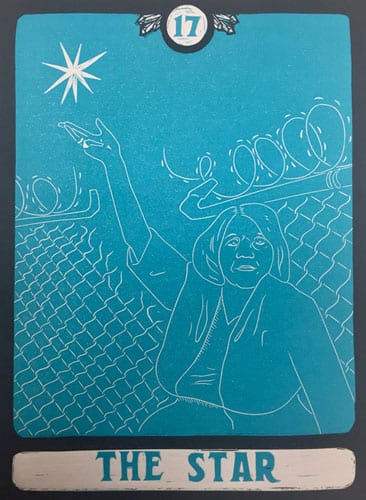Miss Major / Corey Brown

Corey Brown
The Star (Miss Major) turquoise
Guidance, serenity, and hope In the words of Barbara Moore, a well-known modern author of tarot meanings, “Stars have played roles both mystic and mundane in the lives of humans. We like to wish upon a star. Looking at the stars gives us perspective. Stars are used for navigation. The constellations tell stories; we use them to find understanding, direction, and hope. Their gentle yet brilliant light gives comfort and hope in times of darkness. They are not illusionary like the moon nor overwhelming like the sun. They are soft, gentle, and yet amazingly powerful. This card brings refreshment and cleansing after troubles. It promises restored faith and renewed purpose.” Miss Major has been an activist and mentor in the transgender community since the 1960s and was an active participant in the Stonewall Riots of 1969. She moved to California in 1978 and provided support during the AIDS epidemic of the 1980s. She went on to become the Executive Director of the Transgender Gendervariant Intersex Justice Project (TGIJP) which provides direct service and support for trans women, many of whom are of color and currently or formerly incarcerated, and works to fight against the Prison Industrial Complex. I want to honor Miss Major’s legacy and pay tribute to all the guidance, serenity, and hope she has given and continues to give to me and so many other people. She’s still fucking here, just like the stars.
The Queer Ancestors Project
The Queer Ancestors Project is devoted to forging sturdy relationships between LGBTQI people and our ancestors. Using history as a linchpin, we build community by providing Queer and Trans artists, age 18 to 26, free interdisciplinary workshops in printmaking, writing, and Queer history. Public exhibitions and readings of their work provide a window on the past through which the larger community can glimpse our collective future.
The LGBTQI community has a limited visual record, or none at all, of significant Queer events before the 1970s, particularly in the histories of Queers of color and transgender people. This lack of imagery makes it harder for LGBTQI people to connect with, learn from, and be inspired by our history. Just as photographs from your early life help to anchor personal memories, a visual record – even an imagined one – can bring historical events to life, creating the kind of indelible connection that enables us to engage deeply with our ancestors.


